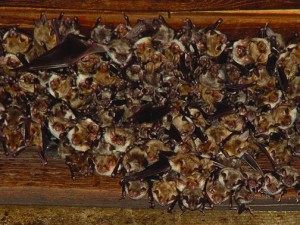Why are Bats Roosting in my House? For professional bat removal in Northern Kentucky, Cincinnati, and Southeast Indiana, call Tri-State Wildlife Management at (859) 635-0037. Put our experience and expertise to work for you!
Bats like many animals are very opportunistic creatures and will take shelter in homes or structures that provide them with easy access from the elements, including wind, rain, and extreme temperatures. Since bats are so small and can fit into crevices or holes as small as 5/8 inch round or 3/8 inch wide by 5/8 inch long, they find many homes to be a suitable place to roost. Bats often enter structures along soffits, fascia, dormer corners, as well as gable and roof vents. These areas often lead into the attic where bats can easily establish a colony for roosting. Although bats may have established your structure as their roost, it may not be their only one. Bats often have multiple roosts where they can seek shelter on any given night. They also have established day time roosts, as they are nocturnal, where they will spend their time sleeping, as well night time roosts where they will stop to rest while out feeding. In addition, they also choose to roost in open spaces such as trees, porches, and bridges on warm summer nights when the weather is favorable.
It is not uncommon to be on a bat exclusion job and have multiple neighbors with the same colony of bats using their structures as an established roost. It is also very common to have similar entry points on these homes due to the neighborhood having structures of the same age, design and quality. Since bats will use adjacent structures as roost sites, neighbors will occasionally see an increase in bat activity near their home after bats are excluded from your structure. Some people will joke that they inherited your bat problem; however this is not the case. They have simply seen an increase in activity since one of the bats’ roost sites have been eliminated, therefore increasing the frequency of their use of their structure.
One of the many mistakes customers make when trying to exclude bats from their home without hiring a knowledgeable professional is assuming all bats have exited a structure prior to making repairs or attempted repairs. Bats can go long periods of time without leaving their roosts for feeding, so one cannot assume that all bats have left the roost on any given night. This is a very serious scenario considering someone could mistakenly trap the bats within the structure. This often leads to a much more serious situation with bats entering the living quarters (which they usually try to avoid) in search of an exit. This is just one of the reasons why a knowledgeable professional is vital to ridding your home or structure of bats.
Bats Roosting in my House Northern Kentucky: If you suspect bats are using your attic as a roost site, do not hesitate to give Tri-State Wildlife Management a call at (859) 635-0037!











